HI5017 Management Accounting Case Studies Analysis
VerifiedAdded on 2022/11/16
|13
|3244
|472
Case Study
AI Summary
This document presents a detailed case study analysis focusing on management accounting principles within a childcare business scenario. It explores various cost types (fixed, variable, operating), analyzes information for effective decision-making (outsourcing vs. in-house laundering), and calculates the costs associated with different laundering options. The analysis extends to employee hiring decisions, evaluating the financial impact of adding staff and additional children. Furthermore, the case study compares relocation options, assessing profitability based on revenue, expenses, and contribution margins under different scenarios. The document also critiques a journal article on innovation management, discussing key components of management accounting and the innovation process. It offers insights into cost analysis, financial planning, and strategic decision-making, providing a valuable resource for students studying management accounting.
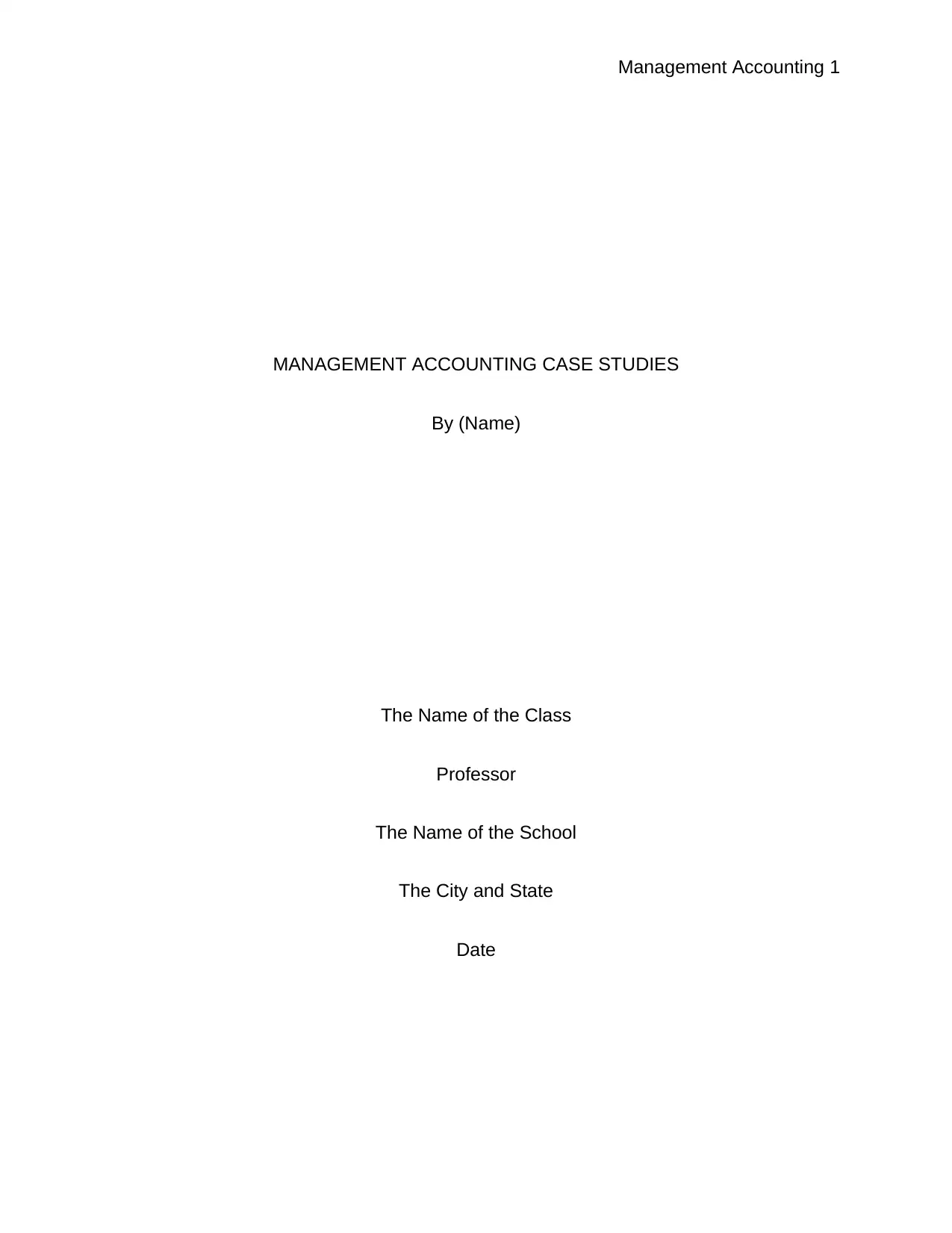
Management Accounting 1
MANAGEMENT ACCOUNTING CASE STUDIES
By (Name)
The Name of the Class
Professor
The Name of the School
The City and State
Date
MANAGEMENT ACCOUNTING CASE STUDIES
By (Name)
The Name of the Class
Professor
The Name of the School
The City and State
Date
Paraphrase This Document
Need a fresh take? Get an instant paraphrase of this document with our AI Paraphraser
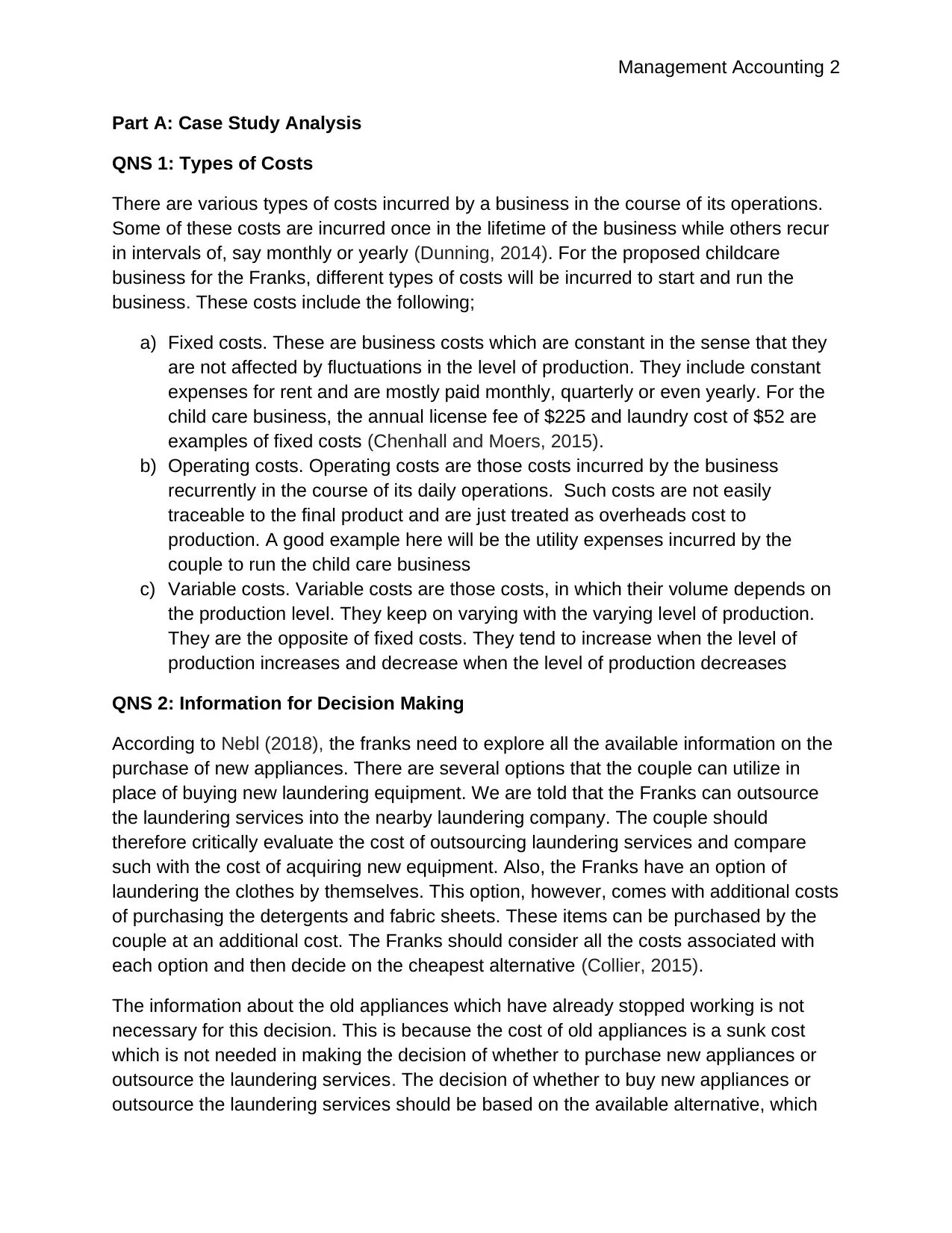
Management Accounting 2
Part A: Case Study Analysis
QNS 1: Types of Costs
There are various types of costs incurred by a business in the course of its operations.
Some of these costs are incurred once in the lifetime of the business while others recur
in intervals of, say monthly or yearly (Dunning, 2014). For the proposed childcare
business for the Franks, different types of costs will be incurred to start and run the
business. These costs include the following;
a) Fixed costs. These are business costs which are constant in the sense that they
are not affected by fluctuations in the level of production. They include constant
expenses for rent and are mostly paid monthly, quarterly or even yearly. For the
child care business, the annual license fee of $225 and laundry cost of $52 are
examples of fixed costs (Chenhall and Moers, 2015).
b) Operating costs. Operating costs are those costs incurred by the business
recurrently in the course of its daily operations. Such costs are not easily
traceable to the final product and are just treated as overheads cost to
production. A good example here will be the utility expenses incurred by the
couple to run the child care business
c) Variable costs. Variable costs are those costs, in which their volume depends on
the production level. They keep on varying with the varying level of production.
They are the opposite of fixed costs. They tend to increase when the level of
production increases and decrease when the level of production decreases
QNS 2: Information for Decision Making
According to Nebl (2018), the franks need to explore all the available information on the
purchase of new appliances. There are several options that the couple can utilize in
place of buying new laundering equipment. We are told that the Franks can outsource
the laundering services into the nearby laundering company. The couple should
therefore critically evaluate the cost of outsourcing laundering services and compare
such with the cost of acquiring new equipment. Also, the Franks have an option of
laundering the clothes by themselves. This option, however, comes with additional costs
of purchasing the detergents and fabric sheets. These items can be purchased by the
couple at an additional cost. The Franks should consider all the costs associated with
each option and then decide on the cheapest alternative (Collier, 2015).
The information about the old appliances which have already stopped working is not
necessary for this decision. This is because the cost of old appliances is a sunk cost
which is not needed in making the decision of whether to purchase new appliances or
outsource the laundering services. The decision of whether to buy new appliances or
outsource the laundering services should be based on the available alternative, which
Part A: Case Study Analysis
QNS 1: Types of Costs
There are various types of costs incurred by a business in the course of its operations.
Some of these costs are incurred once in the lifetime of the business while others recur
in intervals of, say monthly or yearly (Dunning, 2014). For the proposed childcare
business for the Franks, different types of costs will be incurred to start and run the
business. These costs include the following;
a) Fixed costs. These are business costs which are constant in the sense that they
are not affected by fluctuations in the level of production. They include constant
expenses for rent and are mostly paid monthly, quarterly or even yearly. For the
child care business, the annual license fee of $225 and laundry cost of $52 are
examples of fixed costs (Chenhall and Moers, 2015).
b) Operating costs. Operating costs are those costs incurred by the business
recurrently in the course of its daily operations. Such costs are not easily
traceable to the final product and are just treated as overheads cost to
production. A good example here will be the utility expenses incurred by the
couple to run the child care business
c) Variable costs. Variable costs are those costs, in which their volume depends on
the production level. They keep on varying with the varying level of production.
They are the opposite of fixed costs. They tend to increase when the level of
production increases and decrease when the level of production decreases
QNS 2: Information for Decision Making
According to Nebl (2018), the franks need to explore all the available information on the
purchase of new appliances. There are several options that the couple can utilize in
place of buying new laundering equipment. We are told that the Franks can outsource
the laundering services into the nearby laundering company. The couple should
therefore critically evaluate the cost of outsourcing laundering services and compare
such with the cost of acquiring new equipment. Also, the Franks have an option of
laundering the clothes by themselves. This option, however, comes with additional costs
of purchasing the detergents and fabric sheets. These items can be purchased by the
couple at an additional cost. The Franks should consider all the costs associated with
each option and then decide on the cheapest alternative (Collier, 2015).
The information about the old appliances which have already stopped working is not
necessary for this decision. This is because the cost of old appliances is a sunk cost
which is not needed in making the decision of whether to purchase new appliances or
outsource the laundering services. The decision of whether to buy new appliances or
outsource the laundering services should be based on the available alternative, which
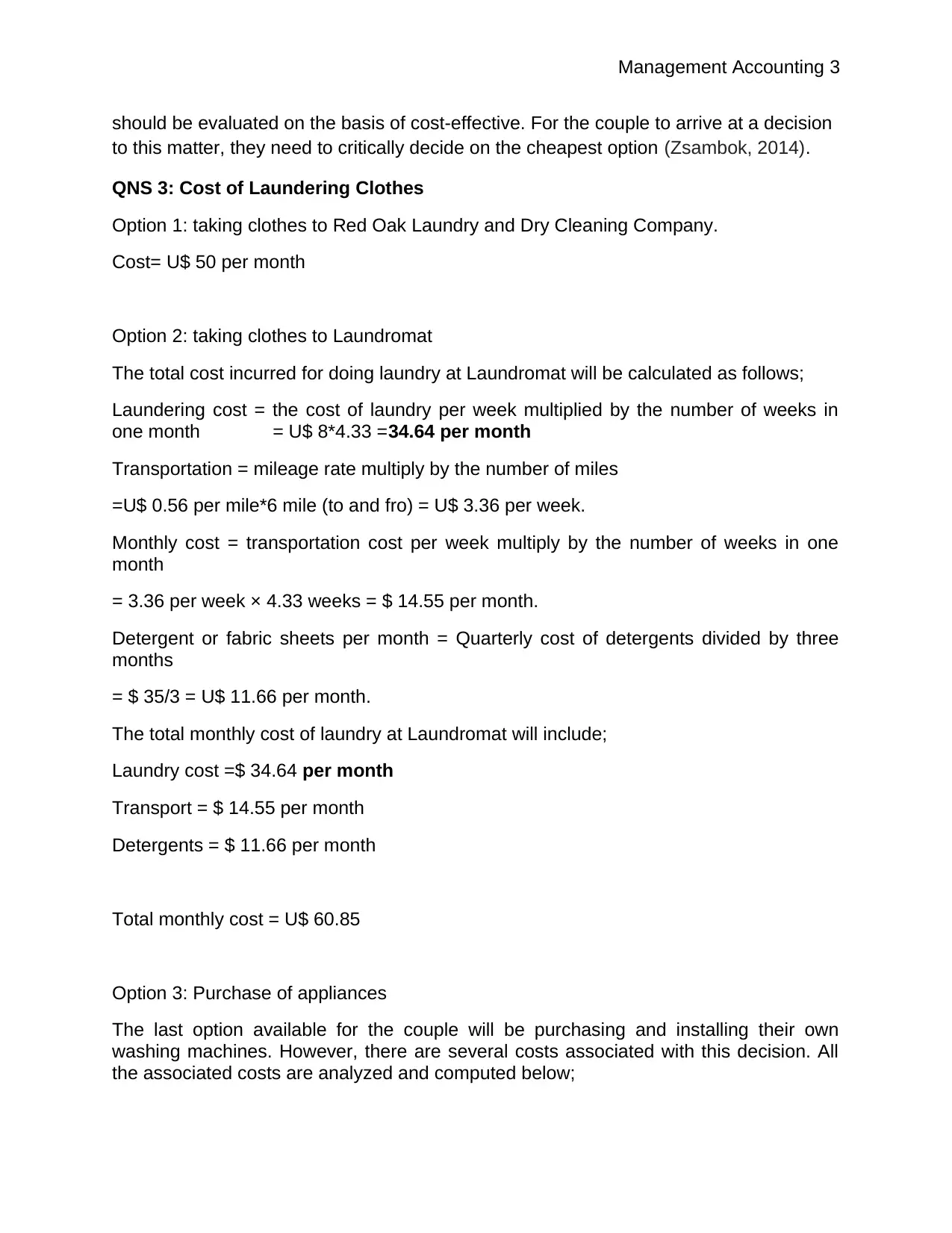
Management Accounting 3
should be evaluated on the basis of cost-effective. For the couple to arrive at a decision
to this matter, they need to critically decide on the cheapest option (Zsambok, 2014).
QNS 3: Cost of Laundering Clothes
Option 1: taking clothes to Red Oak Laundry and Dry Cleaning Company.
Cost= U$ 50 per month
Option 2: taking clothes to Laundromat
The total cost incurred for doing laundry at Laundromat will be calculated as follows;
Laundering cost = the cost of laundry per week multiplied by the number of weeks in
one month = U$ 8*4.33 =34.64 per month
Transportation = mileage rate multiply by the number of miles
=U$ 0.56 per mile*6 mile (to and fro) = U$ 3.36 per week.
Monthly cost = transportation cost per week multiply by the number of weeks in one
month
= 3.36 per week × 4.33 weeks = $ 14.55 per month.
Detergent or fabric sheets per month = Quarterly cost of detergents divided by three
months
= $ 35/3 = U$ 11.66 per month.
The total monthly cost of laundry at Laundromat will include;
Laundry cost =$ 34.64 per month
Transport = $ 14.55 per month
Detergents = $ 11.66 per month
Total monthly cost = U$ 60.85
Option 3: Purchase of appliances
The last option available for the couple will be purchasing and installing their own
washing machines. However, there are several costs associated with this decision. All
the associated costs are analyzed and computed below;
should be evaluated on the basis of cost-effective. For the couple to arrive at a decision
to this matter, they need to critically decide on the cheapest option (Zsambok, 2014).
QNS 3: Cost of Laundering Clothes
Option 1: taking clothes to Red Oak Laundry and Dry Cleaning Company.
Cost= U$ 50 per month
Option 2: taking clothes to Laundromat
The total cost incurred for doing laundry at Laundromat will be calculated as follows;
Laundering cost = the cost of laundry per week multiplied by the number of weeks in
one month = U$ 8*4.33 =34.64 per month
Transportation = mileage rate multiply by the number of miles
=U$ 0.56 per mile*6 mile (to and fro) = U$ 3.36 per week.
Monthly cost = transportation cost per week multiply by the number of weeks in one
month
= 3.36 per week × 4.33 weeks = $ 14.55 per month.
Detergent or fabric sheets per month = Quarterly cost of detergents divided by three
months
= $ 35/3 = U$ 11.66 per month.
The total monthly cost of laundry at Laundromat will include;
Laundry cost =$ 34.64 per month
Transport = $ 14.55 per month
Detergents = $ 11.66 per month
Total monthly cost = U$ 60.85
Option 3: Purchase of appliances
The last option available for the couple will be purchasing and installing their own
washing machines. However, there are several costs associated with this decision. All
the associated costs are analyzed and computed below;
⊘ This is a preview!⊘
Do you want full access?
Subscribe today to unlock all pages.

Trusted by 1+ million students worldwide
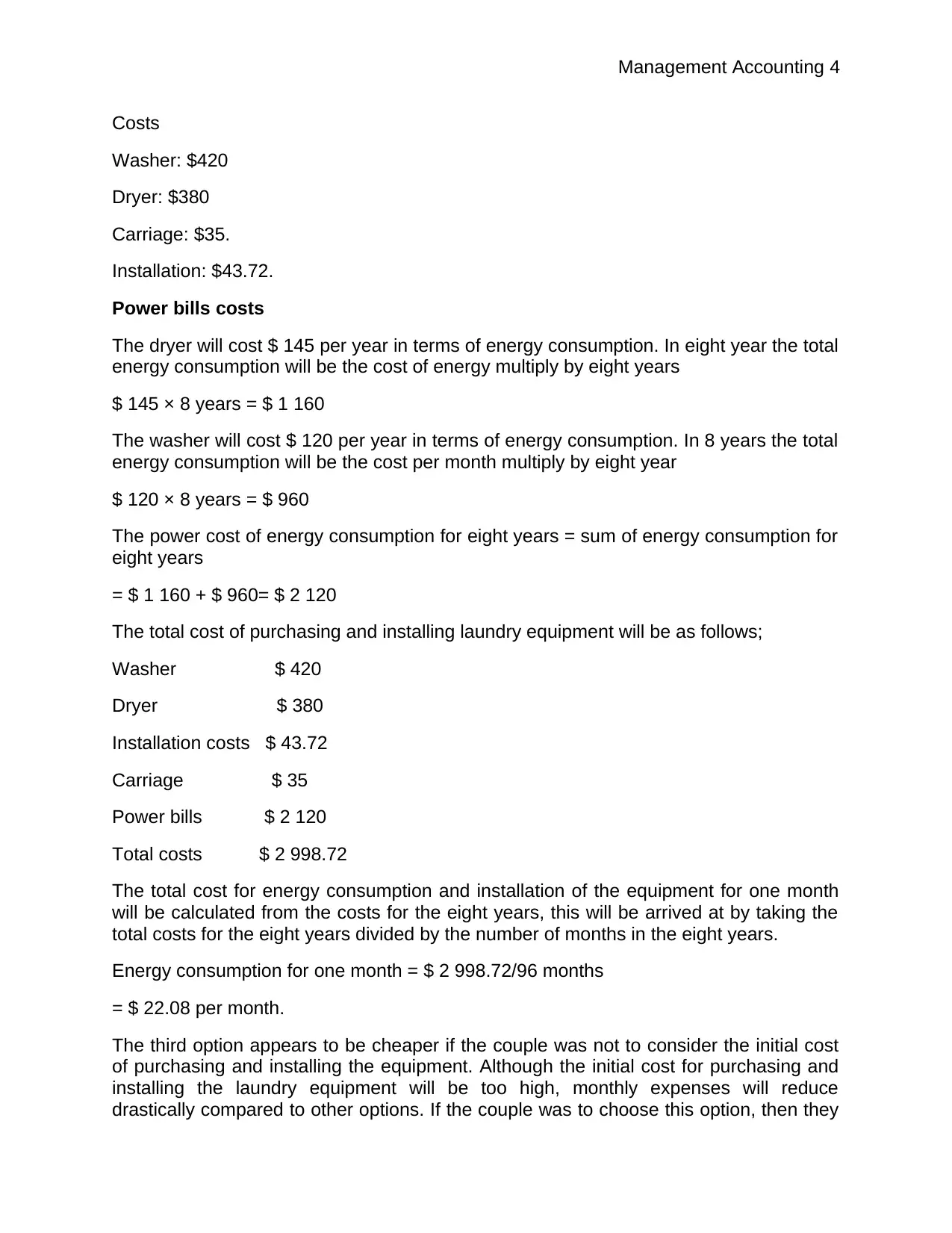
Management Accounting 4
Costs
Washer: $420
Dryer: $380
Carriage: $35.
Installation: $43.72.
Power bills costs
The dryer will cost $ 145 per year in terms of energy consumption. In eight year the total
energy consumption will be the cost of energy multiply by eight years
$ 145 × 8 years = $ 1 160
The washer will cost $ 120 per year in terms of energy consumption. In 8 years the total
energy consumption will be the cost per month multiply by eight year
$ 120 × 8 years = $ 960
The power cost of energy consumption for eight years = sum of energy consumption for
eight years
= $ 1 160 + $ 960= $ 2 120
The total cost of purchasing and installing laundry equipment will be as follows;
Washer $ 420
Dryer $ 380
Installation costs $ 43.72
Carriage $ 35
Power bills $ 2 120
Total costs $ 2 998.72
The total cost for energy consumption and installation of the equipment for one month
will be calculated from the costs for the eight years, this will be arrived at by taking the
total costs for the eight years divided by the number of months in the eight years.
Energy consumption for one month = $ 2 998.72/96 months
= $ 22.08 per month.
The third option appears to be cheaper if the couple was not to consider the initial cost
of purchasing and installing the equipment. Although the initial cost for purchasing and
installing the laundry equipment will be too high, monthly expenses will reduce
drastically compared to other options. If the couple was to choose this option, then they
Costs
Washer: $420
Dryer: $380
Carriage: $35.
Installation: $43.72.
Power bills costs
The dryer will cost $ 145 per year in terms of energy consumption. In eight year the total
energy consumption will be the cost of energy multiply by eight years
$ 145 × 8 years = $ 1 160
The washer will cost $ 120 per year in terms of energy consumption. In 8 years the total
energy consumption will be the cost per month multiply by eight year
$ 120 × 8 years = $ 960
The power cost of energy consumption for eight years = sum of energy consumption for
eight years
= $ 1 160 + $ 960= $ 2 120
The total cost of purchasing and installing laundry equipment will be as follows;
Washer $ 420
Dryer $ 380
Installation costs $ 43.72
Carriage $ 35
Power bills $ 2 120
Total costs $ 2 998.72
The total cost for energy consumption and installation of the equipment for one month
will be calculated from the costs for the eight years, this will be arrived at by taking the
total costs for the eight years divided by the number of months in the eight years.
Energy consumption for one month = $ 2 998.72/96 months
= $ 22.08 per month.
The third option appears to be cheaper if the couple was not to consider the initial cost
of purchasing and installing the equipment. Although the initial cost for purchasing and
installing the laundry equipment will be too high, monthly expenses will reduce
drastically compared to other options. If the couple was to choose this option, then they
Paraphrase This Document
Need a fresh take? Get an instant paraphrase of this document with our AI Paraphraser
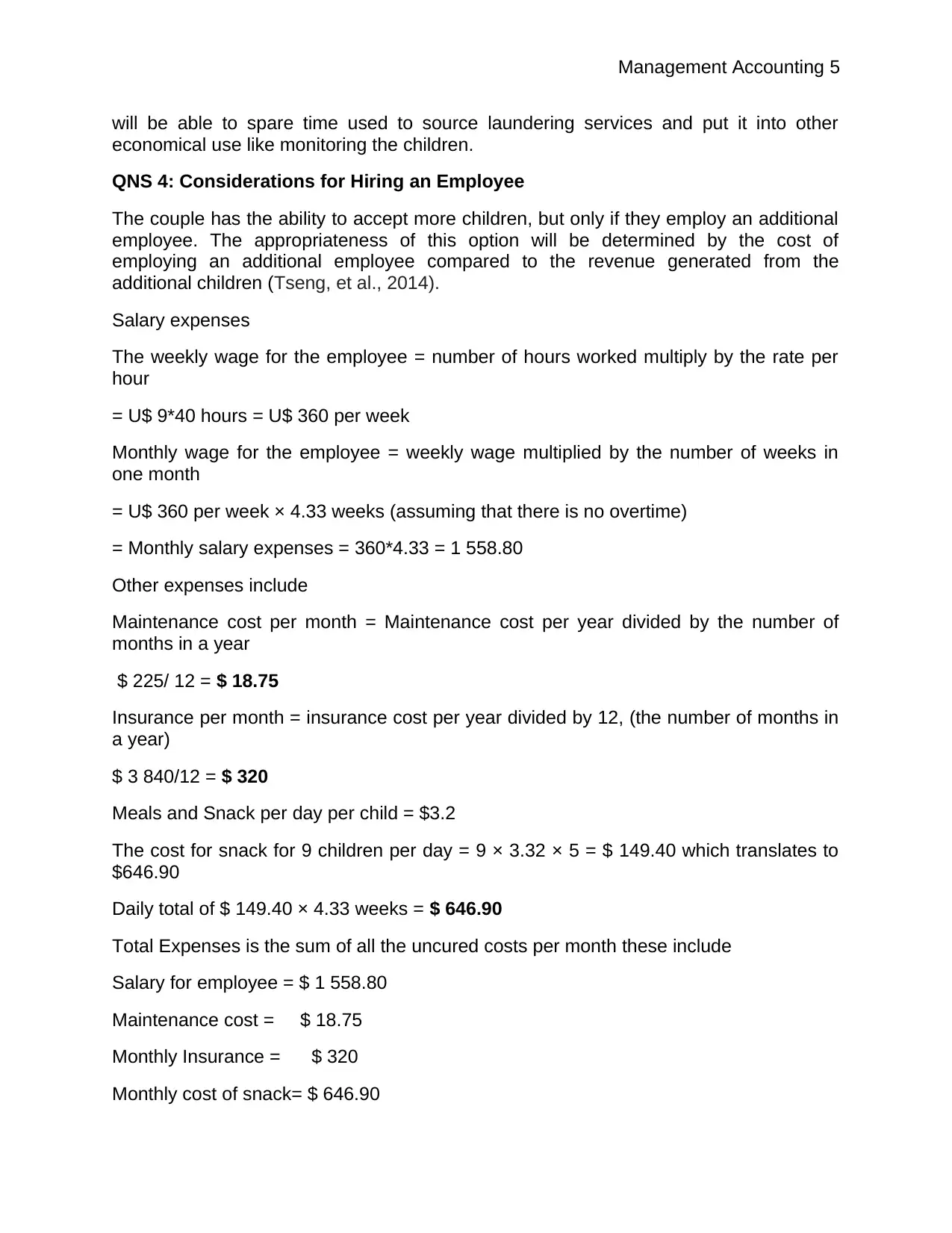
Management Accounting 5
will be able to spare time used to source laundering services and put it into other
economical use like monitoring the children.
QNS 4: Considerations for Hiring an Employee
The couple has the ability to accept more children, but only if they employ an additional
employee. The appropriateness of this option will be determined by the cost of
employing an additional employee compared to the revenue generated from the
additional children (Tseng, et al., 2014).
Salary expenses
The weekly wage for the employee = number of hours worked multiply by the rate per
hour
= U$ 9*40 hours = U$ 360 per week
Monthly wage for the employee = weekly wage multiplied by the number of weeks in
one month
= U$ 360 per week × 4.33 weeks (assuming that there is no overtime)
= Monthly salary expenses = 360*4.33 = 1 558.80
Other expenses include
Maintenance cost per month = Maintenance cost per year divided by the number of
months in a year
$ 225/ 12 = $ 18.75
Insurance per month = insurance cost per year divided by 12, (the number of months in
a year)
$ 3 840/12 = $ 320
Meals and Snack per day per child = $3.2
The cost for snack for 9 children per day = 9 × 3.32 × 5 = $ 149.40 which translates to
$646.90
Daily total of $ 149.40 × 4.33 weeks = $ 646.90
Total Expenses is the sum of all the uncured costs per month these include
Salary for employee = $ 1 558.80
Maintenance cost = $ 18.75
Monthly Insurance = $ 320
Monthly cost of snack= $ 646.90
will be able to spare time used to source laundering services and put it into other
economical use like monitoring the children.
QNS 4: Considerations for Hiring an Employee
The couple has the ability to accept more children, but only if they employ an additional
employee. The appropriateness of this option will be determined by the cost of
employing an additional employee compared to the revenue generated from the
additional children (Tseng, et al., 2014).
Salary expenses
The weekly wage for the employee = number of hours worked multiply by the rate per
hour
= U$ 9*40 hours = U$ 360 per week
Monthly wage for the employee = weekly wage multiplied by the number of weeks in
one month
= U$ 360 per week × 4.33 weeks (assuming that there is no overtime)
= Monthly salary expenses = 360*4.33 = 1 558.80
Other expenses include
Maintenance cost per month = Maintenance cost per year divided by the number of
months in a year
$ 225/ 12 = $ 18.75
Insurance per month = insurance cost per year divided by 12, (the number of months in
a year)
$ 3 840/12 = $ 320
Meals and Snack per day per child = $3.2
The cost for snack for 9 children per day = 9 × 3.32 × 5 = $ 149.40 which translates to
$646.90
Daily total of $ 149.40 × 4.33 weeks = $ 646.90
Total Expenses is the sum of all the uncured costs per month these include
Salary for employee = $ 1 558.80
Maintenance cost = $ 18.75
Monthly Insurance = $ 320
Monthly cost of snack= $ 646.90
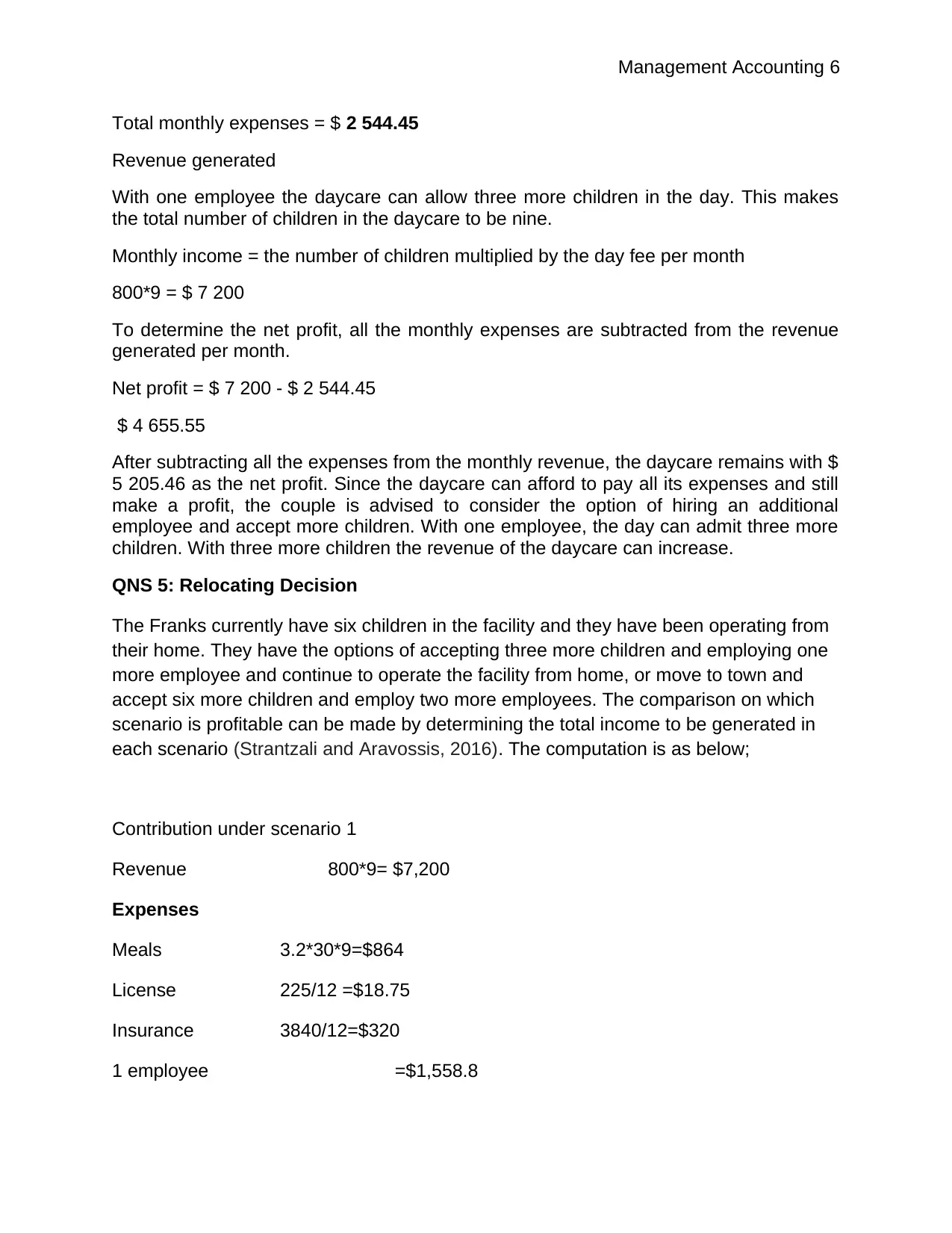
Management Accounting 6
Total monthly expenses = $ 2 544.45
Revenue generated
With one employee the daycare can allow three more children in the day. This makes
the total number of children in the daycare to be nine.
Monthly income = the number of children multiplied by the day fee per month
800*9 = $ 7 200
To determine the net profit, all the monthly expenses are subtracted from the revenue
generated per month.
Net profit = $ 7 200 - $ 2 544.45
$ 4 655.55
After subtracting all the expenses from the monthly revenue, the daycare remains with $
5 205.46 as the net profit. Since the daycare can afford to pay all its expenses and still
make a profit, the couple is advised to consider the option of hiring an additional
employee and accept more children. With one employee, the day can admit three more
children. With three more children the revenue of the daycare can increase.
QNS 5: Relocating Decision
The Franks currently have six children in the facility and they have been operating from
their home. They have the options of accepting three more children and employing one
more employee and continue to operate the facility from home, or move to town and
accept six more children and employ two more employees. The comparison on which
scenario is profitable can be made by determining the total income to be generated in
each scenario (Strantzali and Aravossis, 2016). The computation is as below;
Contribution under scenario 1
Revenue 800*9= $7,200
Expenses
Meals 3.2*30*9=$864
License 225/12 =$18.75
Insurance 3840/12=$320
1 employee =$1,558.8
Total monthly expenses = $ 2 544.45
Revenue generated
With one employee the daycare can allow three more children in the day. This makes
the total number of children in the daycare to be nine.
Monthly income = the number of children multiplied by the day fee per month
800*9 = $ 7 200
To determine the net profit, all the monthly expenses are subtracted from the revenue
generated per month.
Net profit = $ 7 200 - $ 2 544.45
$ 4 655.55
After subtracting all the expenses from the monthly revenue, the daycare remains with $
5 205.46 as the net profit. Since the daycare can afford to pay all its expenses and still
make a profit, the couple is advised to consider the option of hiring an additional
employee and accept more children. With one employee, the day can admit three more
children. With three more children the revenue of the daycare can increase.
QNS 5: Relocating Decision
The Franks currently have six children in the facility and they have been operating from
their home. They have the options of accepting three more children and employing one
more employee and continue to operate the facility from home, or move to town and
accept six more children and employ two more employees. The comparison on which
scenario is profitable can be made by determining the total income to be generated in
each scenario (Strantzali and Aravossis, 2016). The computation is as below;
Contribution under scenario 1
Revenue 800*9= $7,200
Expenses
Meals 3.2*30*9=$864
License 225/12 =$18.75
Insurance 3840/12=$320
1 employee =$1,558.8
⊘ This is a preview!⊘
Do you want full access?
Subscribe today to unlock all pages.

Trusted by 1+ million students worldwide
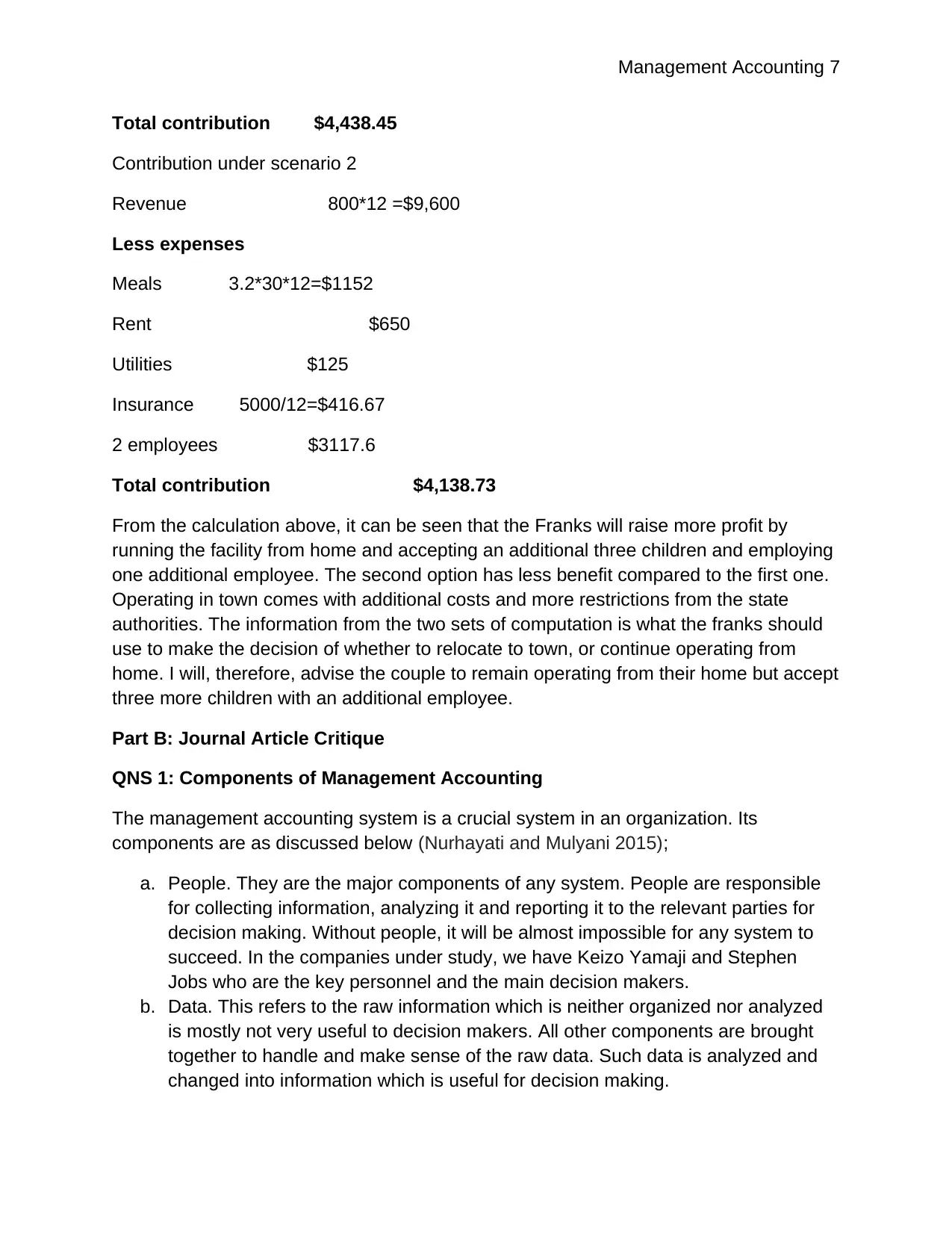
Management Accounting 7
Total contribution $4,438.45
Contribution under scenario 2
Revenue 800*12 =$9,600
Less expenses
Meals 3.2*30*12=$1152
Rent $650
Utilities $125
Insurance 5000/12=$416.67
2 employees $3117.6
Total contribution $4,138.73
From the calculation above, it can be seen that the Franks will raise more profit by
running the facility from home and accepting an additional three children and employing
one additional employee. The second option has less benefit compared to the first one.
Operating in town comes with additional costs and more restrictions from the state
authorities. The information from the two sets of computation is what the franks should
use to make the decision of whether to relocate to town, or continue operating from
home. I will, therefore, advise the couple to remain operating from their home but accept
three more children with an additional employee.
Part B: Journal Article Critique
QNS 1: Components of Management Accounting
The management accounting system is a crucial system in an organization. Its
components are as discussed below (Nurhayati and Mulyani 2015);
a. People. They are the major components of any system. People are responsible
for collecting information, analyzing it and reporting it to the relevant parties for
decision making. Without people, it will be almost impossible for any system to
succeed. In the companies under study, we have Keizo Yamaji and Stephen
Jobs who are the key personnel and the main decision makers.
b. Data. This refers to the raw information which is neither organized nor analyzed
is mostly not very useful to decision makers. All other components are brought
together to handle and make sense of the raw data. Such data is analyzed and
changed into information which is useful for decision making.
Total contribution $4,438.45
Contribution under scenario 2
Revenue 800*12 =$9,600
Less expenses
Meals 3.2*30*12=$1152
Rent $650
Utilities $125
Insurance 5000/12=$416.67
2 employees $3117.6
Total contribution $4,138.73
From the calculation above, it can be seen that the Franks will raise more profit by
running the facility from home and accepting an additional three children and employing
one additional employee. The second option has less benefit compared to the first one.
Operating in town comes with additional costs and more restrictions from the state
authorities. The information from the two sets of computation is what the franks should
use to make the decision of whether to relocate to town, or continue operating from
home. I will, therefore, advise the couple to remain operating from their home but accept
three more children with an additional employee.
Part B: Journal Article Critique
QNS 1: Components of Management Accounting
The management accounting system is a crucial system in an organization. Its
components are as discussed below (Nurhayati and Mulyani 2015);
a. People. They are the major components of any system. People are responsible
for collecting information, analyzing it and reporting it to the relevant parties for
decision making. Without people, it will be almost impossible for any system to
succeed. In the companies under study, we have Keizo Yamaji and Stephen
Jobs who are the key personnel and the main decision makers.
b. Data. This refers to the raw information which is neither organized nor analyzed
is mostly not very useful to decision makers. All other components are brought
together to handle and make sense of the raw data. Such data is analyzed and
changed into information which is useful for decision making.
Paraphrase This Document
Need a fresh take? Get an instant paraphrase of this document with our AI Paraphraser
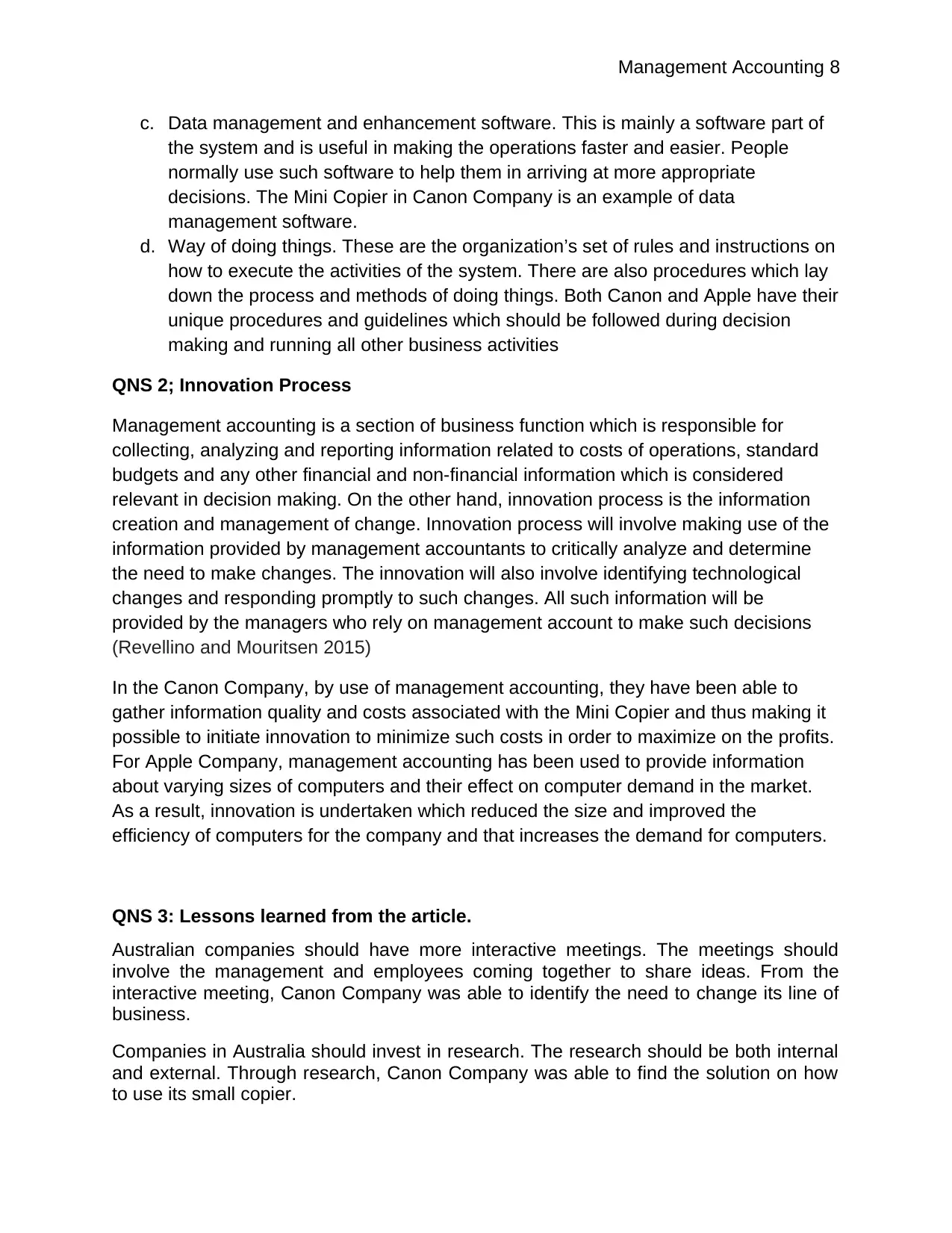
Management Accounting 8
c. Data management and enhancement software. This is mainly a software part of
the system and is useful in making the operations faster and easier. People
normally use such software to help them in arriving at more appropriate
decisions. The Mini Copier in Canon Company is an example of data
management software.
d. Way of doing things. These are the organization’s set of rules and instructions on
how to execute the activities of the system. There are also procedures which lay
down the process and methods of doing things. Both Canon and Apple have their
unique procedures and guidelines which should be followed during decision
making and running all other business activities
QNS 2; Innovation Process
Management accounting is a section of business function which is responsible for
collecting, analyzing and reporting information related to costs of operations, standard
budgets and any other financial and non-financial information which is considered
relevant in decision making. On the other hand, innovation process is the information
creation and management of change. Innovation process will involve making use of the
information provided by management accountants to critically analyze and determine
the need to make changes. The innovation will also involve identifying technological
changes and responding promptly to such changes. All such information will be
provided by the managers who rely on management account to make such decisions
(Revellino and Mouritsen 2015)
In the Canon Company, by use of management accounting, they have been able to
gather information quality and costs associated with the Mini Copier and thus making it
possible to initiate innovation to minimize such costs in order to maximize on the profits.
For Apple Company, management accounting has been used to provide information
about varying sizes of computers and their effect on computer demand in the market.
As a result, innovation is undertaken which reduced the size and improved the
efficiency of computers for the company and that increases the demand for computers.
QNS 3: Lessons learned from the article.
Australian companies should have more interactive meetings. The meetings should
involve the management and employees coming together to share ideas. From the
interactive meeting, Canon Company was able to identify the need to change its line of
business.
Companies in Australia should invest in research. The research should be both internal
and external. Through research, Canon Company was able to find the solution on how
to use its small copier.
c. Data management and enhancement software. This is mainly a software part of
the system and is useful in making the operations faster and easier. People
normally use such software to help them in arriving at more appropriate
decisions. The Mini Copier in Canon Company is an example of data
management software.
d. Way of doing things. These are the organization’s set of rules and instructions on
how to execute the activities of the system. There are also procedures which lay
down the process and methods of doing things. Both Canon and Apple have their
unique procedures and guidelines which should be followed during decision
making and running all other business activities
QNS 2; Innovation Process
Management accounting is a section of business function which is responsible for
collecting, analyzing and reporting information related to costs of operations, standard
budgets and any other financial and non-financial information which is considered
relevant in decision making. On the other hand, innovation process is the information
creation and management of change. Innovation process will involve making use of the
information provided by management accountants to critically analyze and determine
the need to make changes. The innovation will also involve identifying technological
changes and responding promptly to such changes. All such information will be
provided by the managers who rely on management account to make such decisions
(Revellino and Mouritsen 2015)
In the Canon Company, by use of management accounting, they have been able to
gather information quality and costs associated with the Mini Copier and thus making it
possible to initiate innovation to minimize such costs in order to maximize on the profits.
For Apple Company, management accounting has been used to provide information
about varying sizes of computers and their effect on computer demand in the market.
As a result, innovation is undertaken which reduced the size and improved the
efficiency of computers for the company and that increases the demand for computers.
QNS 3: Lessons learned from the article.
Australian companies should have more interactive meetings. The meetings should
involve the management and employees coming together to share ideas. From the
interactive meeting, Canon Company was able to identify the need to change its line of
business.
Companies in Australia should invest in research. The research should be both internal
and external. Through research, Canon Company was able to find the solution on how
to use its small copier.
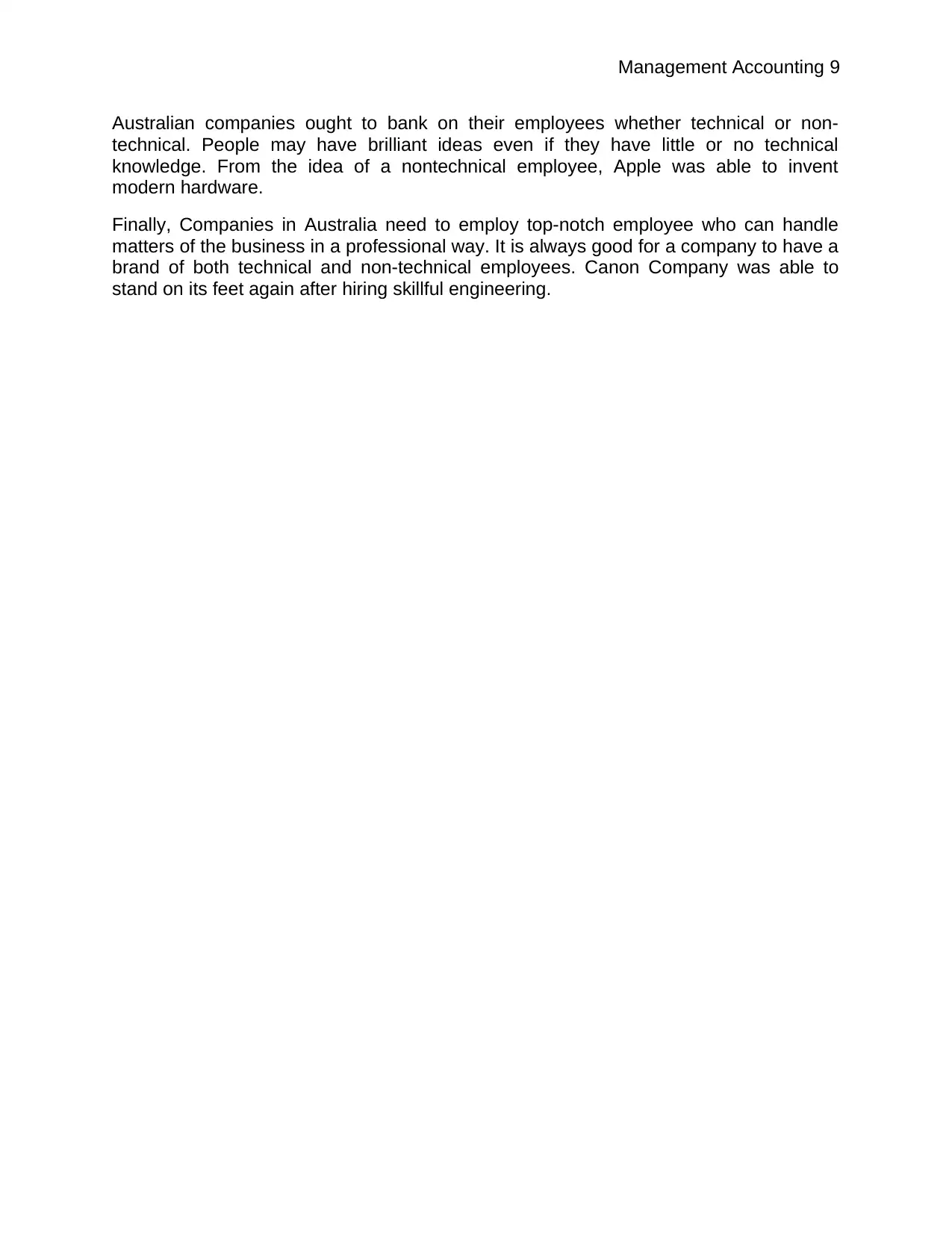
Management Accounting 9
Australian companies ought to bank on their employees whether technical or non-
technical. People may have brilliant ideas even if they have little or no technical
knowledge. From the idea of a nontechnical employee, Apple was able to invent
modern hardware.
Finally, Companies in Australia need to employ top-notch employee who can handle
matters of the business in a professional way. It is always good for a company to have a
brand of both technical and non-technical employees. Canon Company was able to
stand on its feet again after hiring skillful engineering.
Australian companies ought to bank on their employees whether technical or non-
technical. People may have brilliant ideas even if they have little or no technical
knowledge. From the idea of a nontechnical employee, Apple was able to invent
modern hardware.
Finally, Companies in Australia need to employ top-notch employee who can handle
matters of the business in a professional way. It is always good for a company to have a
brand of both technical and non-technical employees. Canon Company was able to
stand on its feet again after hiring skillful engineering.
⊘ This is a preview!⊘
Do you want full access?
Subscribe today to unlock all pages.

Trusted by 1+ million students worldwide
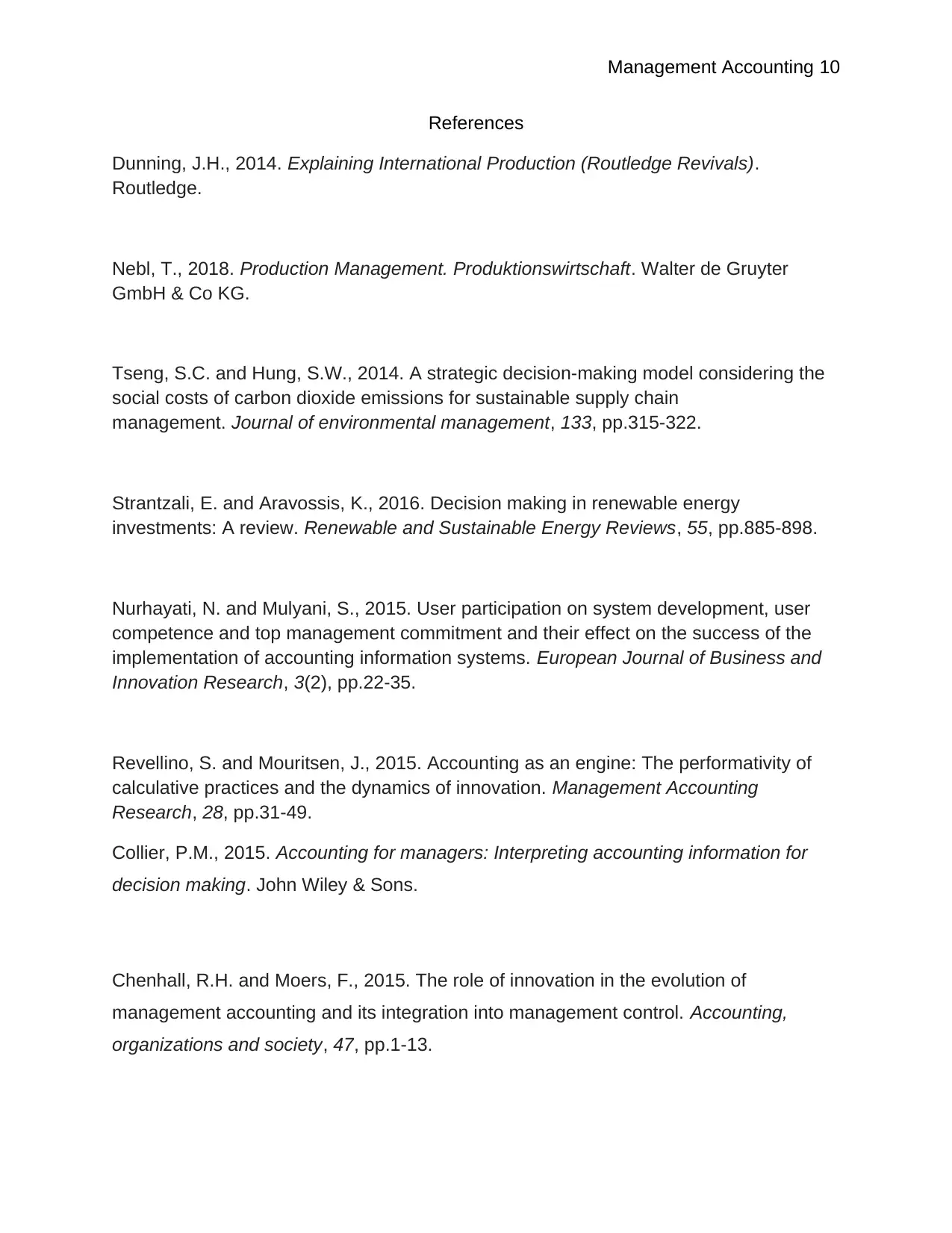
Management Accounting 10
References
Dunning, J.H., 2014. Explaining International Production (Routledge Revivals).
Routledge.
Nebl, T., 2018. Production Management. Produktionswirtschaft. Walter de Gruyter
GmbH & Co KG.
Tseng, S.C. and Hung, S.W., 2014. A strategic decision-making model considering the
social costs of carbon dioxide emissions for sustainable supply chain
management. Journal of environmental management, 133, pp.315-322.
Strantzali, E. and Aravossis, K., 2016. Decision making in renewable energy
investments: A review. Renewable and Sustainable Energy Reviews, 55, pp.885-898.
Nurhayati, N. and Mulyani, S., 2015. User participation on system development, user
competence and top management commitment and their effect on the success of the
implementation of accounting information systems. European Journal of Business and
Innovation Research, 3(2), pp.22-35.
Revellino, S. and Mouritsen, J., 2015. Accounting as an engine: The performativity of
calculative practices and the dynamics of innovation. Management Accounting
Research, 28, pp.31-49.
Collier, P.M., 2015. Accounting for managers: Interpreting accounting information for
decision making. John Wiley & Sons.
Chenhall, R.H. and Moers, F., 2015. The role of innovation in the evolution of
management accounting and its integration into management control. Accounting,
organizations and society, 47, pp.1-13.
References
Dunning, J.H., 2014. Explaining International Production (Routledge Revivals).
Routledge.
Nebl, T., 2018. Production Management. Produktionswirtschaft. Walter de Gruyter
GmbH & Co KG.
Tseng, S.C. and Hung, S.W., 2014. A strategic decision-making model considering the
social costs of carbon dioxide emissions for sustainable supply chain
management. Journal of environmental management, 133, pp.315-322.
Strantzali, E. and Aravossis, K., 2016. Decision making in renewable energy
investments: A review. Renewable and Sustainable Energy Reviews, 55, pp.885-898.
Nurhayati, N. and Mulyani, S., 2015. User participation on system development, user
competence and top management commitment and their effect on the success of the
implementation of accounting information systems. European Journal of Business and
Innovation Research, 3(2), pp.22-35.
Revellino, S. and Mouritsen, J., 2015. Accounting as an engine: The performativity of
calculative practices and the dynamics of innovation. Management Accounting
Research, 28, pp.31-49.
Collier, P.M., 2015. Accounting for managers: Interpreting accounting information for
decision making. John Wiley & Sons.
Chenhall, R.H. and Moers, F., 2015. The role of innovation in the evolution of
management accounting and its integration into management control. Accounting,
organizations and society, 47, pp.1-13.
Paraphrase This Document
Need a fresh take? Get an instant paraphrase of this document with our AI Paraphraser
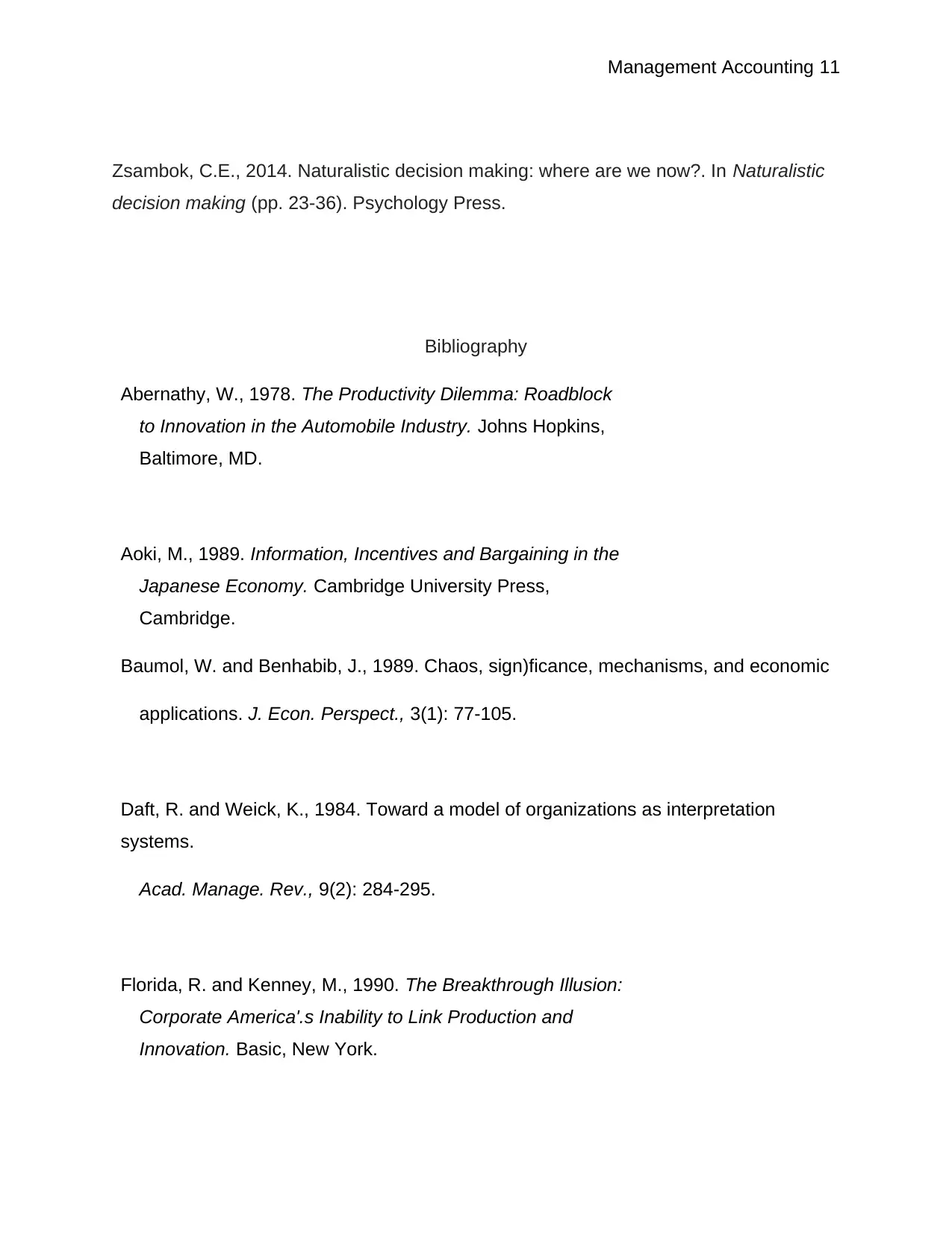
Management Accounting 11
Zsambok, C.E., 2014. Naturalistic decision making: where are we now?. In Naturalistic
decision making (pp. 23-36). Psychology Press.
Bibliography
Abernathy, W., 1978. The Productivity Dilemma: Roadblock
to Innovation in the Automobile Industry. Johns Hopkins,
Baltimore, MD.
Aoki, M., 1989. Information, Incentives and Bargaining in the
Japanese Economy. Cambridge University Press,
Cambridge.
Baumol, W. and Benhabib, J., 1989. Chaos, sign)ficance, mechanisms, and economic
applications. J. Econ. Perspect., 3(1): 77-105.
Daft, R. and Weick, K., 1984. Toward a model of organizations as interpretation
systems.
Acad. Manage. Rev., 9(2): 284-295.
Florida, R. and Kenney, M., 1990. The Breakthrough Illusion:
Corporate America'.s Inability to Link Production and
Innovation. Basic, New York.
Zsambok, C.E., 2014. Naturalistic decision making: where are we now?. In Naturalistic
decision making (pp. 23-36). Psychology Press.
Bibliography
Abernathy, W., 1978. The Productivity Dilemma: Roadblock
to Innovation in the Automobile Industry. Johns Hopkins,
Baltimore, MD.
Aoki, M., 1989. Information, Incentives and Bargaining in the
Japanese Economy. Cambridge University Press,
Cambridge.
Baumol, W. and Benhabib, J., 1989. Chaos, sign)ficance, mechanisms, and economic
applications. J. Econ. Perspect., 3(1): 77-105.
Daft, R. and Weick, K., 1984. Toward a model of organizations as interpretation
systems.
Acad. Manage. Rev., 9(2): 284-295.
Florida, R. and Kenney, M., 1990. The Breakthrough Illusion:
Corporate America'.s Inability to Link Production and
Innovation. Basic, New York.
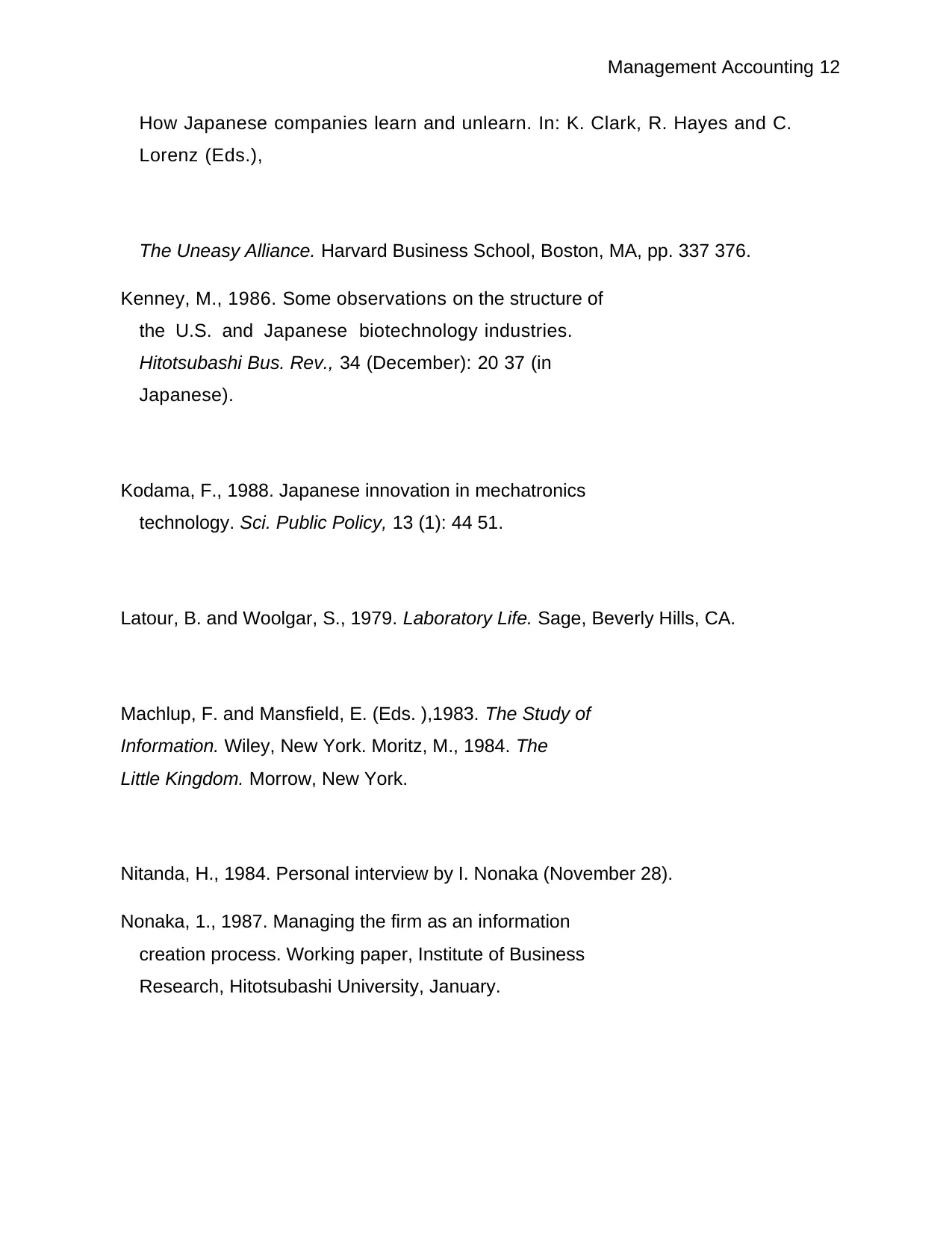
Management Accounting 12
How Japanese companies learn and unlearn. In: K. Clark, R. Hayes and C.
Lorenz (Eds.),
The Uneasy Alliance. Harvard Business School, Boston, MA, pp. 337 376.
Kenney, M., 1986. Some observations on the structure of
the U.S. and Japanese biotechnology industries.
Hitotsubashi Bus. Rev., 34 (December): 20 37 (in
Japanese).
Kodama, F., 1988. Japanese innovation in mechatronics
technology. Sci. Public Policy, 13 (1): 44 51.
Latour, B. and Woolgar, S., 1979. Laboratory Life. Sage, Beverly Hills, CA.
Machlup, F. and Mansfield, E. (Eds. ),1983. The Study of
Information. Wiley, New York. Moritz, M., 1984. The
Little Kingdom. Morrow, New York.
Nitanda, H., 1984. Personal interview by I. Nonaka (November 28).
Nonaka, 1., 1987. Managing the firm as an information
creation process. Working paper, Institute of Business
Research, Hitotsubashi University, January.
How Japanese companies learn and unlearn. In: K. Clark, R. Hayes and C.
Lorenz (Eds.),
The Uneasy Alliance. Harvard Business School, Boston, MA, pp. 337 376.
Kenney, M., 1986. Some observations on the structure of
the U.S. and Japanese biotechnology industries.
Hitotsubashi Bus. Rev., 34 (December): 20 37 (in
Japanese).
Kodama, F., 1988. Japanese innovation in mechatronics
technology. Sci. Public Policy, 13 (1): 44 51.
Latour, B. and Woolgar, S., 1979. Laboratory Life. Sage, Beverly Hills, CA.
Machlup, F. and Mansfield, E. (Eds. ),1983. The Study of
Information. Wiley, New York. Moritz, M., 1984. The
Little Kingdom. Morrow, New York.
Nitanda, H., 1984. Personal interview by I. Nonaka (November 28).
Nonaka, 1., 1987. Managing the firm as an information
creation process. Working paper, Institute of Business
Research, Hitotsubashi University, January.
⊘ This is a preview!⊘
Do you want full access?
Subscribe today to unlock all pages.

Trusted by 1+ million students worldwide
1 out of 13
Related Documents
Your All-in-One AI-Powered Toolkit for Academic Success.
+13062052269
info@desklib.com
Available 24*7 on WhatsApp / Email
![[object Object]](/_next/static/media/star-bottom.7253800d.svg)
Unlock your academic potential
Copyright © 2020–2025 A2Z Services. All Rights Reserved. Developed and managed by ZUCOL.





